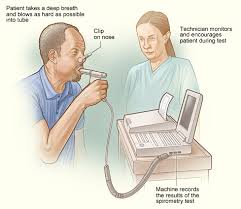
SPIROMETRY
Spirometry is a common pulmonary function test (PFT) that measures how well your lungs workAbout SPIROMETRY
It's a safe, painless, and non-invasive procedure that can help diagnose lung diseases such as asthma, chronic obstructive pulmonary disease (COPD), and cystic fibrosis.
pen_spark
Spirometer machine
How Spirometry Works
During a spirometry test, you'll be seated in a comfortable position and asked to wear a nose clip to prevent air from escaping through your nose. You'll then be given a mouthpiece connected to a spirometer, a machine that measures the volume and speed of your exhaled air.
The technician will guide you through a series of breathing maneuvers, which may include:
- Taking a deep breath in and then blowing out as hard and fast as you can for at least six seconds (forced vital capacity or FVC)
- Taking a series of rapid, shallow breaths in and out (forced expiratory volume in one second or FEV1)
The spirometer will record the results of your breathing maneuvers and generate a printout or display them on a computer screen. The technician will then compare your results to normal values for your age, height, sex, and race.
What Spirometry Measures
Spirometry measures several different lung functions, including:
- Forced vital capacity (FVC): The total amount of air you can forcefully exhale after taking a deep breath.
- Forced expiratory volume in one second (FEV1): The amount of air you can forcefully exhale in one second.
- FEV1/FVC ratio: This ratio is obtained by dividing your FEV1 by your FVC. It reflects how quickly you can exhale air from your lungs.
Uses of Spirometry
Spirometry is used for a variety of purposes, including:
- Diagnosing lung diseases: Spirometry can help diagnose lung diseases such as asthma, COPD, and cystic fibrosis. It can also help identify other lung conditions, such as emphysema and pulmonary fibrosis.
- Monitoring lung disease: Spirometry can be used to monitor the progression of lung disease and the effectiveness of treatment.
- Assessing lung function before surgery: Spirometry may be used to assess your lung function before surgery to ensure that you can tolerate the procedure.
- Screening for lung disease: Spirometry may be used to screen for lung disease in people who are at high risk, such as smokers.
Benefits of Spirometry
Spirometry is a simple, safe, and painless test that can provide valuable information about your lung function. It is a key tool for diagnosing and managing lung diseases.